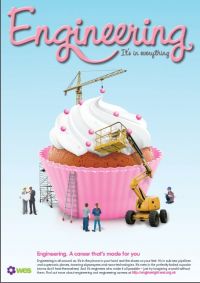
This project was undertaken for the Women’s Engineering Society (WES), working in association with Oxford Research and Policy and funded by the Royal Academy of Engineering.
Katalytik undertook:
- Focus groups with girls in school years 7 to 10
- Focus groups with undergraduate women engineers
- Managed the design team to produce a poster
- Management and co-authorship of the report ‘Diversity in Engineering’
The images for the final ‘cupcake’ poster can be ordered from the WES office (info@wes.org.uk) and downloaded from the project site. The poster design and colours were considered and tested using the target group of girls. The poster detail can be found on the project website.
The study findings and recommendations are in the following summary and full report.
Engaging girls in engineering – targeting groups
A framework for identifying target groups of girls for interventions was developed for this project based on descriptions in the literature and on the field work carried out as part of the project.
Girls can be grouped into those that naturally have a positive predisposition and attitude towards engineering and technology subjects – the “do” group – and those that “don’t”. Girls in the “don’t” group may be capable in STEM subjects. Among the “do” group are those who “will” go on to follow a path that leads to STEM A Levels and possibly to the study of engineering or technology beyond compulsory education. Some of the “do” group, however, have clear ideas of careers outside engineering and technology such as wanting to be a doctor, lawyer or part of another clearly identified profession and hence “won’t” go on to engineering or technology careers.
Among the “don’t” group there are girls who have clear ideas of careers outside engineering and technology and hence also fall into the “won’t” group.
There is also a group from among the “don’t” girls who “could” follow engineering and technology paths.
This group is of particular interest: they are the girls that “could” follow engineering or technology careers as they are capable in STEM subjects, but whose personal identities and influences are very different from the “do” group and consequently do not have a positive predisposition towards engineering and technology.
The main challenge is to engage the “could” group in discussion and debate during the critical period between year 5 and year 8 (ages 8 to 13) so that they have an innate awareness of what engineering is about.
